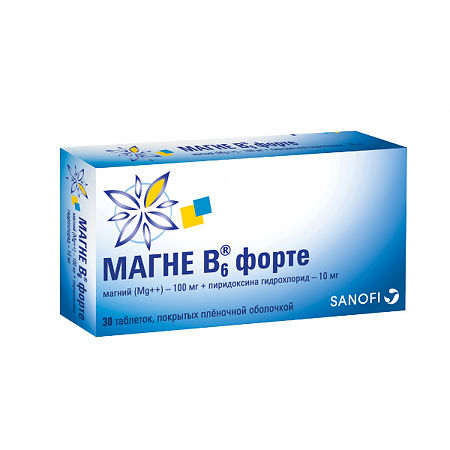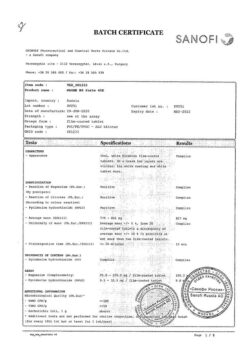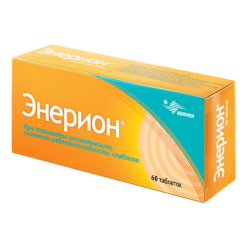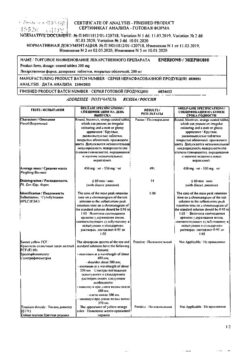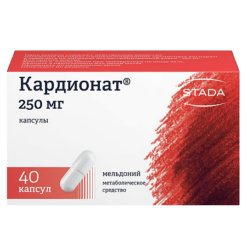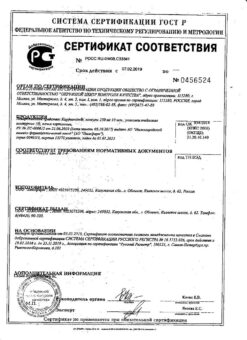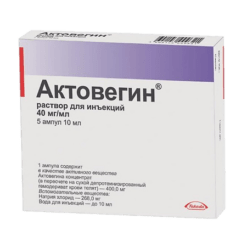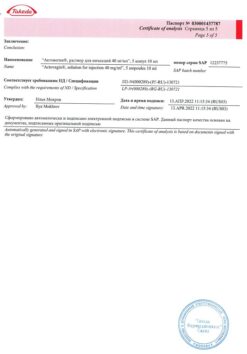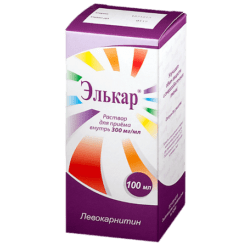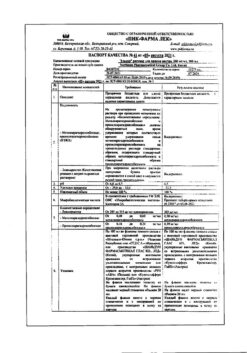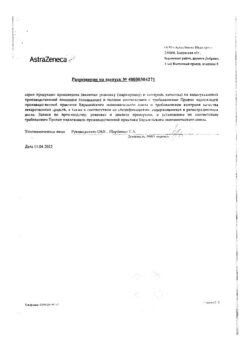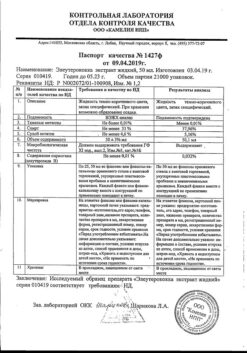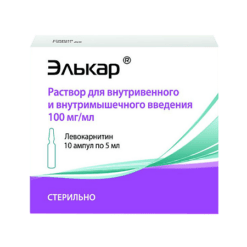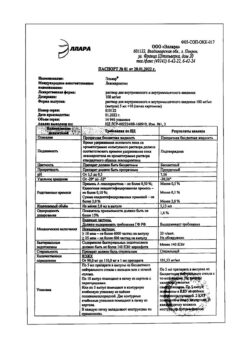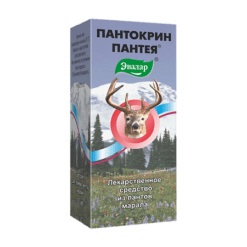No products in the cart.
Magne B6 forte, 30 pcs.
€1.00
Out of stock
(E-mail when Stock is available)
Description
Magnesium is a vital element that is necessary for the normal functioning of cells and is involved in most metabolic reactions.
In particular, it is involved in the regulation of nerve impulse transmission and muscle contraction. 1/3 of the amount of magnesium in the body is stored in bone tissue. The body gets magnesium with food. Lack of magnesium in the body can be observed when the diet is disturbed (diet) or when the need for magnesium increases.
Pyridoxine (vitamin B6) is involved in many metabolic processes, improves the absorption of magnesium from the gastrointestinal tract and its penetration into cells.
Serum magnesium levels:
- between 12 and 17 mg/L (1 – 1.4 mEq/L or 0.5 – 0.7 mmol/L): indicate moderate magnesium deficiency
- below 12 mg/L (1 mEq/L or 0.5 mmol/L): indicate severe magnesium deficiency.
Pharmacokinetics
Gastrointestinal absorption of magnesium salts occurs in part by a passive mechanism in which salt solubility plays a determining role. The degree of this absorption does not exceed 50%. Excretion occurs mainly by the kidneys.
Indications
Indications
Established magnesium deficiency, isolated or associated with other deficiency conditions, accompanied by symptoms such as increased irritability, minor sleep disturbances, gastrointestinal cramps, rapid heartbeat, increased fatigue, muscle pain and spasms, and a tingling sensation in the muscles.
If after a month of treatment there is no improvement in these symptoms, continuing treatment is not advisable.
Pharmacological effect
Pharmacological effect
Magnesium is a vital element that is necessary for the normal functioning of cells and is involved in most metabolic reactions.
In particular, it is involved in the regulation of the transmission of nerve impulses and muscle contraction. 1/3 of the amount of magnesium contained in the body accumulates in bone tissue. The body receives magnesium through food. A lack of magnesium in the body can occur when the diet is disrupted or when the need for magnesium increases.
Pyridoxine (vitamin B6) is involved in many metabolic processes and helps improve the absorption of magnesium from the gastrointestinal tract and its penetration into cells.
Serum magnesium levels:
between 12 and 17 mg/L (1 – 1.4 mEq/L or 0.5 – 0.7 mmol/L): indicate mild magnesium deficiency
Below 12 mg/L (1 mEq/L or 0.5 mmol/L): indicates severe magnesium deficiency.
Pharmacokinetics
Gastrointestinal absorption of magnesium salts occurs partly through a passive mechanism in which the solubility of the salt plays a determining role. The degree of this absorption does not exceed 50%. Excretion occurs mainly by the kidneys.
Special instructions
Special instructions
The tablets are intended only for adults and children over 6 years of age. In case of moderate renal failure, the drug should be taken with caution due to the risk of developing hypermagnesemia. If there is a simultaneous deficiency of calcium and magnesium, the magnesium deficiency should be replenished before supplemental calcium intake.
When pyridoxine is used in high doses for a long time (over several months or in some cases, years), sensory neuropathy may develop, which is accompanied by symptoms such as numbness and vestibular disorders, tremor of the distal extremities and gradually developing sensory ataxia (impaired coordination of movements). These disorders are usually reversible and disappear after discontinuation of high doses of vitamin B.
Active ingredient
Active ingredient
Magnesium, Pyridoxine
Composition
Composition
Active ingredients:
magnesium citrate – 618.43 mg, which corresponds to 100 mg of magnesium (Mg++),
pyridoxine hydrochloride – 10.00 mg;
Excipients:
lactose – 50.57 mg,
macrogol-6000 – 120.00 mg,
magnesium stearate – 1.00 mg;
Tablet shell:
hypromellose 6 mPa.s – 14.08 mg,
macrogol-6000 – 1.17 mg,
titanium dioxide (E 171) – 4.75 mg,
talc – traces
Pregnancy
Pregnancy
During pregnancy, the drug is taken only on the recommendation of a doctor.
Taking into account that magnesium passes into breast milk, if it is necessary to take the drug, it is recommended to stop breastfeeding.
Contraindications
Contraindications
Age up to 6 years (efficacy and safety have not been established).
Severe renal failure (creatinine clearance less than 30 ml/min).
Hypersensitivity to any of the components of the drug.
Phenylketonuria.
Hereditary galactosemia, glucose and galactose malabsorption syndrome or lactase deficiency (due to the presence of lactose in the composition of the drug).
Concomitant use of levodopa. With caution: moderate renal failure (risk of developing hypermagnesemia).
Side Effects
Side Effects
Immune system disorders: allergic reactions, including skin reactions;
Gastrointestinal disorders: diarrhea, abdominal pain, nausea, vomiting, flatulence.
Interaction
Interaction
Contraindicated combinations With levodopa: the activity of levodopa is inhibited by pyridoxine (unless taking this drug is combined with taking inhibitors of peripheral aromatic L-amino acid decarboxylase).
Any amount of pyridoxine should be avoided unless levodopa is taken in combination with peripheral aromatic L-amino acid decarboxylase inhibitors.
Not recommended combinations
The simultaneous use of drugs containing phosphates or calcium salts may impair the absorption of magnesium in the intestine.
Combinations to consider
When prescribing tetracyclines orally, it is necessary to maintain an interval of at least 3 hours between ingestion of tetracycline and Magne B6® forte, because Magnesium preparations reduce the absorption of tetracyclines.
Overdose
Overdose
Symptoms: With normal kidney function, an overdose of magnesium when taken orally usually does not lead to toxic reactions. However, in case of renal failure, magnesium poisoning may develop.
Symptoms of overdose, the severity of which depends on the concentration of magnesium in the blood: decreased blood pressure; nausea, vomiting; depression of the central nervous system, decreased reflexes; changes in the electrocardiogram; respiratory depression, coma, cardiac arrest and respiratory paralysis; anuric syndrome.
Treatment: rehydration, forced diuresis. In case of renal failure, hemodialysis or peritoneal dialysis is necessary.
Storage conditions
Storage conditions
Store at a temperature not exceeding 30 C.
Shelf life
Shelf life
2 years
Manufacturer
Manufacturer
Hinoine Pharmaceutical and Chemical Plant, Hungary
Additional information
| Shelf life | 2 years |
|---|---|
| Conditions of storage | Store at a temperature not exceeding 30 C. |
| Manufacturer | Hinoin Pharmaceutical and Chemical Works, Hungary |
| Medication form | pills |
| Brand | Hinoin Pharmaceutical and Chemical Works |
Other forms…
Related products
Buy Magne B6 forte, 30 pcs. with delivery to USA, UK, Europe and over 120 other countries.

